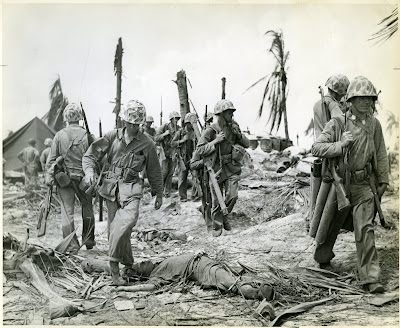 |
| From: http://www.kwajaleinscubaclub.com/ |
The mightiest amphibious invasion force (up until that time) in World War II assembled off its shores in February 1944. The battle that followed was one of the most successful American operations against the Japanese of the War - but few remember it.
 |
| Marines of the 4th Division mop up after taking Roi-Namur Island at Kwajalein Atoll, February 1944. |
Although it is public knowledge, Americans are generally also unaware that most of the significant testing on our anti-ballistic missile defenses was conducted at Kwajalein over the last fifty years. The remote islands, and giant lagoon, are an ideal spot to receive target missiles from other locations and to launch interceptor missiles to defeat them high in the atmosphere. An amazing array of very powerful radars and sensors are in place to detect, track and target incoming test missiles. Those same radars are used by NASA and other agencies to monitor space debris and missile tests.
 |
| 24 January 1962 – The Kwajalein ZEUS Acquisition Radar (ZAR) received its first signal returns from an ICBM, the initial test of the ZAR against a real target. Courtesy USASMDC Historical Office |
The US Army Kwajalein Atoll (USAKA) is managed by the US Army Space and Missile Defense Command on Redstone Arsenal, at Huntsville Alabama. A host of laboratories and command centers, spread all over the United States, analyze the data that is gathered during these test activities. With today’s computer and fiber optic connectivity, integrating all of the test data from radars, optical sensors, cameras and the missiles themselves can be done swiftly. Fifty years ago it was a time consuming challenge that worked across antiquated and non- standard computer servers, at multiple locations, none of which could communicate with one another.
Some very smart people at the Pentagon developed a system that could bring all of those various mainframe computers in line, speaking a common language. The result was the direct ancestor of the internet.
Charles Herzfeld of the missile defense program at the Advanced Research Project Agency (ARPA) wanted an interconnected chain of computers where each operator could communicate with the others, with as much ease as a telephone. You can read the full story of how Charles Herzfeld developed the Arpanet at this link.
So, now you know how a remote Army test site in the central Pacific helped lead to the development of Internet technology. You’ll know the truth the next time some politician claims that he invented it!


No comments:
Post a Comment